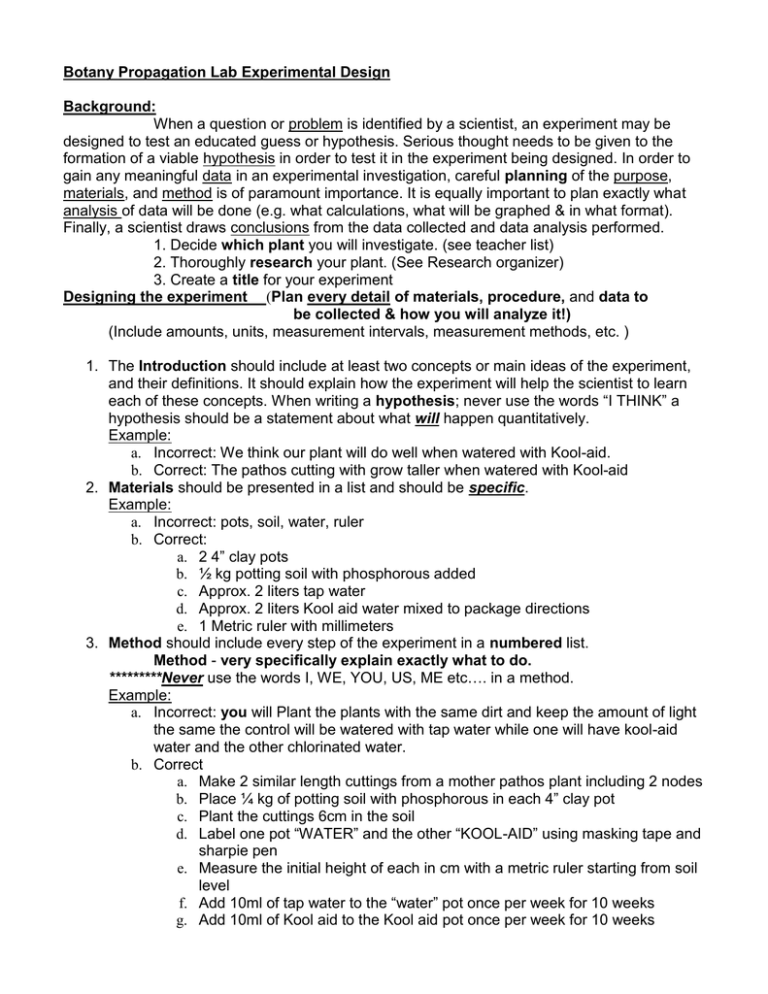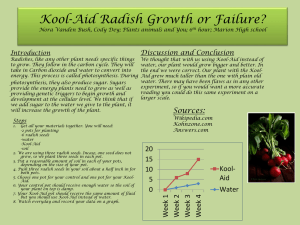Botany Propagation Lab Experimental Design Background:
advertisement

Botany Propagation Lab Experimental Design Background: When a question or problem is identified by a scientist, an experiment may be designed to test an educated guess or hypothesis. Serious thought needs to be given to the formation of a viable hypothesis in order to test it in the experiment being designed. In order to gain any meaningful data in an experimental investigation, careful planning of the purpose, materials, and method is of paramount importance. It is equally important to plan exactly what analysis of data will be done (e.g. what calculations, what will be graphed & in what format). Finally, a scientist draws conclusions from the data collected and data analysis performed. 1. Decide which plant you will investigate. (see teacher list) 2. Thoroughly research your plant. (See Research organizer) 3. Create a title for your experiment Designing the experiment (Plan every detail of materials, procedure, and data to be collected & how you will analyze it!) (Include amounts, units, measurement intervals, measurement methods, etc. ) 1. The Introduction should include at least two concepts or main ideas of the experiment, and their definitions. It should explain how the experiment will help the scientist to learn each of these concepts. When writing a hypothesis; never use the words “I THINK” a hypothesis should be a statement about what will happen quantitatively. Example: a. Incorrect: We think our plant will do well when watered with Kool-aid. b. Correct: The pathos cutting with grow taller when watered with Kool-aid 2. Materials should be presented in a list and should be specific. Example: a. Incorrect: pots, soil, water, ruler b. Correct: a. 2 4” clay pots b. ½ kg potting soil with phosphorous added c. Approx. 2 liters tap water d. Approx. 2 liters Kool aid water mixed to package directions e. 1 Metric ruler with millimeters 3. Method should include every step of the experiment in a numbered list. Method - very specifically explain exactly what to do. *********Never use the words I, WE, YOU, US, ME etc…. in a method. Example: a. Incorrect: you will Plant the plants with the same dirt and keep the amount of light the same the control will be watered with tap water while one will have kool-aid water and the other chlorinated water. b. Correct a. Make 2 similar length cuttings from a mother pathos plant including 2 nodes b. Place ¼ kg of potting soil with phosphorous in each 4” clay pot c. Plant the cuttings 6cm in the soil d. Label one pot “WATER” and the other “KOOL-AID” using masking tape and sharpie pen e. Measure the initial height of each in cm with a metric ruler starting from soil level f. Add 10ml of tap water to the “water” pot once per week for 10 weeks g. Add 10ml of Kool aid to the Kool aid pot once per week for 10 weeks h. Using a metric ruler, measure the height in cm of each cutting starting from soil level once per week for 10 weeks. i. Record data on data table. 4. Be sure to provide a control group as well as an experimental group *Note: Change or test only one variable at a time. Possible variables to consider: Amount & composition of fertilizer Soil composition Rate & timing of fertilizer application Size, shape, composition of pot Amount of water Rooting compounds Rate & timing of water application Special types of fertilizer Method of water application Root stimulating compounds Temperature of water 5. Data collection : Data should be quantifiable (ie. measurable with a metric ruler) Some qualitative observations may be appropriate such as “greener”. Example: a. Incorrect: growth, health, best, learning, do well b. Correct: height, germination rate, percentage germination, length of roots, number of leaves, number of sprouts, height of plant measured from soil level. 6. Data tables should reflect the data being recorded. Design yours. Include headings & units. Example: Plant Growth: Water v.s. Koolaid Date: Height (cm) WATER Height (cm) KOOLAID 7. Other things to consider a. Are you going to be able to control the variables? a. You will not be controlling light, temperature or humidity b. If you plan to use materials that are not currently available in the green house you will need to purchase them. b. Pay attention to the research you did a. Understand the watering requirements of your plants- if your plants like to dry out between watering you probably don’t want to water every M W & F b. Understand the soil requirements- if you’re not testing soil differences, be sure you are using the best soil for your plant c. Understand the cultivation methods- some cuttings grow best when rooted in water, others just need to be planted in soil or sand. Check your research to be sure you are going to get the best results and that you are not adding unnecessary steps c. All measurements should be made in metric units- no inches, feet, cups, etc. 8. Analysis Plan how you will analyze your data. Will you calculate anything? What? What will you graph? What? What format would be illustrate your results?(Line? Bar? Pie?) Look for trends and patterns that indicate what happened during the experiment. SPELL CHECK YOUR EXPERIMENTAL DESIGN






